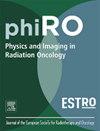Organs at risk proximity in central lung stereotactic ablative radiotherapy: A comparison of four-dimensional computed tomography and magnetic resonance-guided breath-hold delivery techniques
IF 3.3
Q2 ONCOLOGY
引用次数: 0
Abstract
Higher toxicity rates are associated with stereotactic ablative radiotherapy (SABR) to central lung tumors. Breath-hold (BH) magnetic resonance-guided SABR (MR-SABR) can reduce doses to organs at risk (OAR). We quantified the planning target volumes (PTV) to OAR distance in 45 lesions treated using MR-SABR and generated a corresponding four-dimensional computed tomography (4D-CT) based PTV (motion-encompassing internal target volume plus 5 mm). For lesions located ≦3 cm from airways, BH MR-SABR increased the median PTV distance to OAR by 3.7 mm. For lesions ≦3 cm from pericardium, median PTV-OAR separation increased by 2.0 mm with BH. These findings highlight the advantage of BH SABR for central lung tumors.
中央肺立体定向消融放疗中危险器官邻近:四维计算机断层扫描和磁共振引导屏气传送技术的比较
较高的毒性率与立体定向消融放疗(SABR)对中央肺肿瘤有关。屏气(BH)磁共振引导SABR (MR-SABR)可以减少对危险器官(OAR)的剂量。我们量化了使用MR-SABR治疗的45个病变的规划靶体积(PTV)到OAR距离,并生成了相应的基于四维计算机断层扫描(4D-CT)的PTV(包含运动的内部靶体积加5mm)。对于距离气道≦3cm的病变,BH MR-SABR使PTV距桨叶的中位距离增加3.7 mm。病灶距心包≦3cm者,PTV-OAR中位距离随BH增加2.0 mm。这些发现突出了BH SABR在中枢性肺肿瘤中的优势。
本文章由计算机程序翻译,如有差异,请以英文原文为准。
求助全文
约1分钟内获得全文
求助全文
来源期刊

Physics and Imaging in Radiation Oncology
Physics and Astronomy-Radiation
CiteScore
5.30
自引率
18.90%
发文量
93
审稿时长
6 weeks
 求助内容:
求助内容: 应助结果提醒方式:
应助结果提醒方式:


